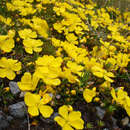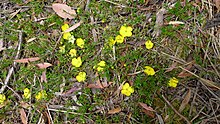en
names in breadcrumbs


Hibbertia procumbens, commonly known as spreading guinea flower,[2] is a species of flowering plant in the family Dilleniaceae and is endemic to south-eastern Australia. It is a prostrate, often mat-forming shrub with more or less glabrous stems, linear to narrow lance-shaped leaves with the narrower end towards the base, and yellow flowers with eighteen to twenty-five stamens arranged in groups around usually four glabrous carpels.
Hibbertia obtusifolia is a prostrate, often mat-forming shrub with more or less glabrous branches up to 30 cm (12 in) long. The leaves are linear to lance-shaped with the narrower end towards the base, 3–19 mm (0.12–0.75 in) long and 0.4–2.1 mm (0.016–0.083 in) wide with a rounded end and usually a groove along the upper surface. The flowers are arranged on the ends of branches and are sessile, surrounded by a cluster of up to six leaves. The sepals are 5.3–10.5 mm (0.21–0.41 in) long and of unequal lengths. The petals are bright yellow, egg-shaped with the narrower end towards the base, and 4.0–15 mm (0.16–0.59 in) long. There are eighteen to twenty-five stamens arranged in groups around usually four glabrous carpels. Flowering occurs from October to December.[2][3][4][5]
Spreading guinea flower was first formally described in 1806 by Jacques Labillardière who gave it the name Dillenia procumbens in Novae Hollandiae Plantarum Specimen.[6][7] In 1817, Augustin Pyramus de Candolle changed the name to Hibbertia procumbens in Regni Vegetabilis Systema Naturale.[8][9] The specific epithet (procumbens) means "low-lying".
Spreading guinea flower occurs in New South Wales, Victoria and Tasmania, growing in sandy soil, usually in heath. It is widespread and common in Tasmania, found in near-coastal areas of southern Victoria, but rare in New South Wales where it only occurs on the Central Coast near Somersby, Kulnura and Mangrove Mountain.[2][3][5][10]
Hibbertia procumbens is listed as "endangered" under the New South Wales Government Biodiversity Conservation Act 2016.[5]
 Habit
Habit Hibbertia procumbens, commonly known as spreading guinea flower, is a species of flowering plant in the family Dilleniaceae and is endemic to south-eastern Australia. It is a prostrate, often mat-forming shrub with more or less glabrous stems, linear to narrow lance-shaped leaves with the narrower end towards the base, and yellow flowers with eighteen to twenty-five stamens arranged in groups around usually four glabrous carpels.
Hibbertia procumbens (Labill.) DC. – gatunek rośliny z rzędu ukęślowców (Dilleniales Hutch.). Występuje naturalnie w południowo-zachodniej części Australii – w stanach Nowa Południowa Walia, Wiktoria oraz Tasmania[3][4].
Hibbertia procumbens (Labill.) DC. – gatunek rośliny z rzędu ukęślowców (Dilleniales Hutch.). Występuje naturalnie w południowo-zachodniej części Australii – w stanach Nowa Południowa Walia, Wiktoria oraz Tasmania.